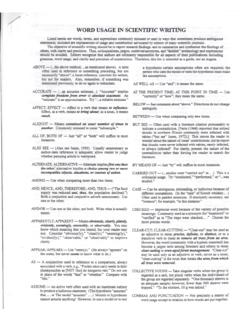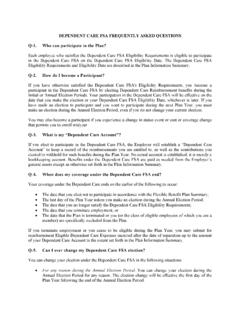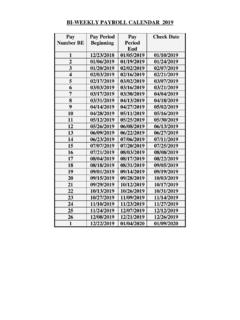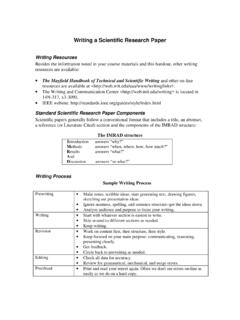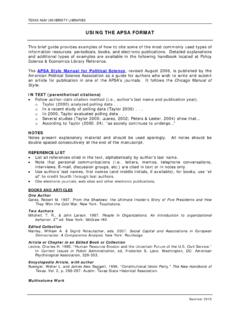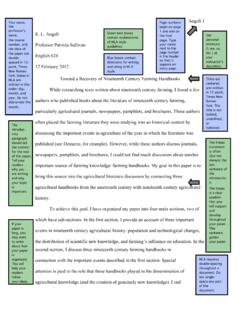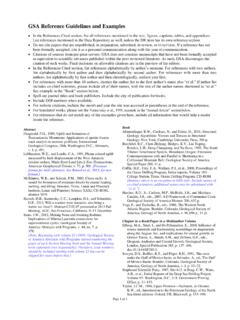Transcription of How to Write Paper in Scientific Journal Style and Format
1 How to Write a Paper in Scientific Journal Style and Format Reprinted from the On line Resources Website resources/resources/ Department of Biology Bates College Lewiston, ME v. 10 2014 This is a reference sheet to help you remember the common Format we expect you to use on your formal lab Write ups. Refer to the How to Write Guide for the details. Other than the title, use 12 point type, preferably Calibri, Times New Roman, or Courier. The title may be up to 16 point and bold if you like. Insert spaces as shown between section headings and text. ** The title goes here, centered justified, not capitalized. Author 1 and Author 2 Department of Biology, Bates College Lewiston, Maine ABSTRACT (brief synopsis of Paper ) (section headings centered, all capitals; bold optional) [Abstract Text here one paragraph; double spaced; left justify] INTRODUCTION (context and purpose of study) [Intro Text here multiple paragraphs; double spaced; all references cited] MATERIALS AND METHODS (how you did the study) [M&M Text here multiple paragraphs; double spaced; subheadings useful] Subheadings (left justify; in italics OR underlined; bold optional) RESULTS (objective presentation of what you found out) [Results Text here usually multiple paragraphs always have Results text before Tables or Figures]; Tables Figures best on pages separate from text, but soon after reference to them; subheadings sometimes useful.
2 Subheadings (left justify; in italics OR underlined; bold optional) DISCUSSION (what do your results mean; interpretation in the context of the greater problem) [Discussion Text here multiple paragraphs; double spaced, all references cited; subheadings sometimes useful] Subheadings (left justify; in italics OR underlined; bold optional) ACKNOWLEDGEMENTS (optional acknowledge the assistance of others, sources of funding, etc) LITERATURE CITED (Articles should be listed alphabetically by first author last name; allow one space between entries. DO NOT alphabetize the names in the authors list in a Paper for an article report as listed.) Example: Journal article Janac k, S., Svensson, B., and E. MacGregor. 2003. Relation between domain evolution specificity and taxonomy of the alpha amylase family members containing a c terminal starch binding domain. Eur J Biochem 270(4):635 645. In text citation Format : ..(Janac k et al, 2003).
3 (note use of et al given 3 or more authors) .. | Table of Contents | How to Use This Guide | References | Acknowledgments | This guide has been compiled, edited, and revised by Greg Anderson of the Bates CollegeDepartment of Biology. The guide is intended to provide general content, Style , and formatguidelines for biology students learning to Write papers in a standard, Scientific Journal styleand Format that can be easily adapted to specific Journal requirements or disciplinaryconventions. Much of the specific content has been shaped by the particular needs of thebeginning Scientific writers in our biology program. We therefore make no claims aboutcompleteness or depth for more advanced writers in the biological sciences, or those in otherscience disciplines. Many excellent published Style manuals for Scientific exist for graduatestudents and professional Scientific writiers. The guidelines presented here are largely basedupon the CBE Style Manual (Huth et al 1994), and we provide suggestions as to other usefulpublished writing guides.
4 How to Use This GuideWe provide this website as a introductory guide for writing a Journal Style Scientific Paper in astandard Format acceptable for most courses in the Biology Department. We suggest that youeither have this document running in your browser while you are writing to provide quickanswers regarding Style and Format , or to print a copy for easy reference anytime. Mostsections of the document are now available as printer friendly pdf files. To print hardcopy ofthe information use the File, Print option in your browser or pdf section is accessed from the Table of Contents and within each section you will find linksto other relevant information. Link menus are provided at the top of each page to facilitaterapid access of the information for which you are looking. A menu at the bottom of each pageallows quick return to the Table of Contents or to the On Line Resources home page. Top of PageReferencesHuth J, Brogan M, Dancik B, Kommedahl T, Nadziejka D, Robinson P, Swanson Scientificformat and Style : The CBE manual for authors, editors, and publishers.
5 Cambridge: CambridgeUniversity Press. 825 thanks to Seri Lowell, the Scientific Writing Specialist at the Writing at Bates Programfor her invaluable comments that have greatly improved this guide during its most recentrevision. This guide was originally inspired by a document which came to Bates College fromAdelle Binning, a visiting faculty member in Biology at Bates College (1987 88), who excerptedit from a document written by William S. Brooks of Ripon College. Some material waspatterned on a similar guide prepared by of Hamilton College. I am grateful toKathleen O'Connor and her students in the Bowdoin College Writing Fellows program whoHow to Write Guide: About this Guideh ~ganderso/biology/resources/wri of 210/2/2014 2:34 PMgraciously critiqued an early version of this document and whose comments have improved itgreatly. My wife, Patsy Dickinson, of the Bowdoin College Department of Biology, hasprovided invaluable critical feedback at many stages in its development.
6 Finally, many thanksto the primary user group, the Natural Sciences students at Bates College who continuallyprovide invaluable feedback on the organization, content, and utility of this welcome and encourage feedback from others who may use this guide and ask that it bedirected to:Greg Anderson (email: of Biology44 Campus Avenue,Bates College, Lewiston, ME 04240 ~ganderso/ Modified 1 11 12 Department of Biology, Bates College, Lewiston, ME 04240 How to Write Guide: About this Guideh ~ganderso/biology/resources/wri of 210/2/2014 2:34 PMHow to Write a Paper in Scientific Journal Style and Format (pdf) Bates College ~ganderso/biology/resources/ 1 Introduction to Journal - Style Scientific Writing [ Table of Contents ] | Get Your Thoughts Organized | Who is Your Audience? | Prose and Style | Abbreviations and Tense | First vs. Third Person | Use Active Verbs | References | Plagiarism Overview A critical aspect of the Scientific process is the reporting of new results in Scientific journals in order to disseminate that information to the larger community of scientists.)
7 Communication of your results contributes to the pool of knowledge within your discipline (and others!) and very often provides information that helps others interpret their own experimental results. Most journals accept papers for publication only after peer review by a small group of scientists who work in the same field and who recommend the Paper be published (usually with some revision). The Format and structure presented here is a general one; the various Scientific journals, and oftentimes specific disciplines, utilize slightly different formats and/or writing styles . Mastery of the Format presented here will enable you to adapt easily to most Journal - or discipline-specific formats. While this guide (a others like it) is a necessary tool of learning the Scientific writing Style and Format , it is not sufficient, by itself, to make you an accomplished writer. This guide will not teach you how to Write in the English language, , it is not a grammar book.
8 You, the writer, must practice writing and thinking within this structure, and, learn by example from the writings of others; learning the nuances of this Style and Format will be enhanced as you read the Scientific literature - pay attention to how professional scientists Write about their work. You will see improvement in your own Scientific writing skills by repeatedly practicing reading, writing, and critiquing of other s writing. The guide addresses four major aspects of writing Journal - Style Scientific papers: (1) Fundamental Style considerations; (2) a suggested strategy for efficiently writing up research results; (3) the nuts and bolts of Format and content of each section of a Paper (part of learning to Write a Scientific Paper is learning how to follow instructions precisely), and, (4) basic information regarding peer critiques of Scientific writing. ALL journals have a set of instructions for authors which explicitly state how their Paper should be formatted for submission.
9 Consider this guide to be your instructions when writing lab reports for the Biology core courses. We encourage you to follow the directions carefully and to make full use of this guide and the writing support system (TWAs, instructors, and Writing Workshop staff tutors) as you prepare your papers. Please ask for help if you have questions about Format , Style , or content. Above all, remember to Write with precision, clarity, and economy. How to Write a Paper in Scientific Journal Style and Format (pdf) Bates College ~ganderso/biology/resources/ 2 Getting Started The first task to accomplish as you begin the process of writing is to order and organize the information you wish to present. Some people work well from an outline, others do not. Some people Write first to discover the points, then rearrange them using an after-the-fact outline. Whatever process you may use, be aware that Scientific writing requires special attention to order and organization.
10 Because the Paper will be divided into sections, you need to know what information will go into each. If you don't normally work from an outline, this may be an occasion when you'll at least want to develop a list of the major points to be included in each section, before you begin to Write . If the Paper has multiple authors, then this is a good time to work (and negotiate!) with your collaborators to insure that all the points the group wants to make get listed. Audience: Who will be reading your Paper ? Usually you will be writing to your peers. Simple advice: address your Paper to another interested biology student, or lab group, in this course or major, and assume they have at least the same knowledge and expertise base as you. Knowing your audience helps you to decide what information to include--you would Write a very different article for a narrow, highly technical, disciplinary Journal vs. one that went out to a broad range of disciplines. Similarly, you would Write a Paper for an audience of other biology majors very differently than one you would Write for a cross section of the college.
